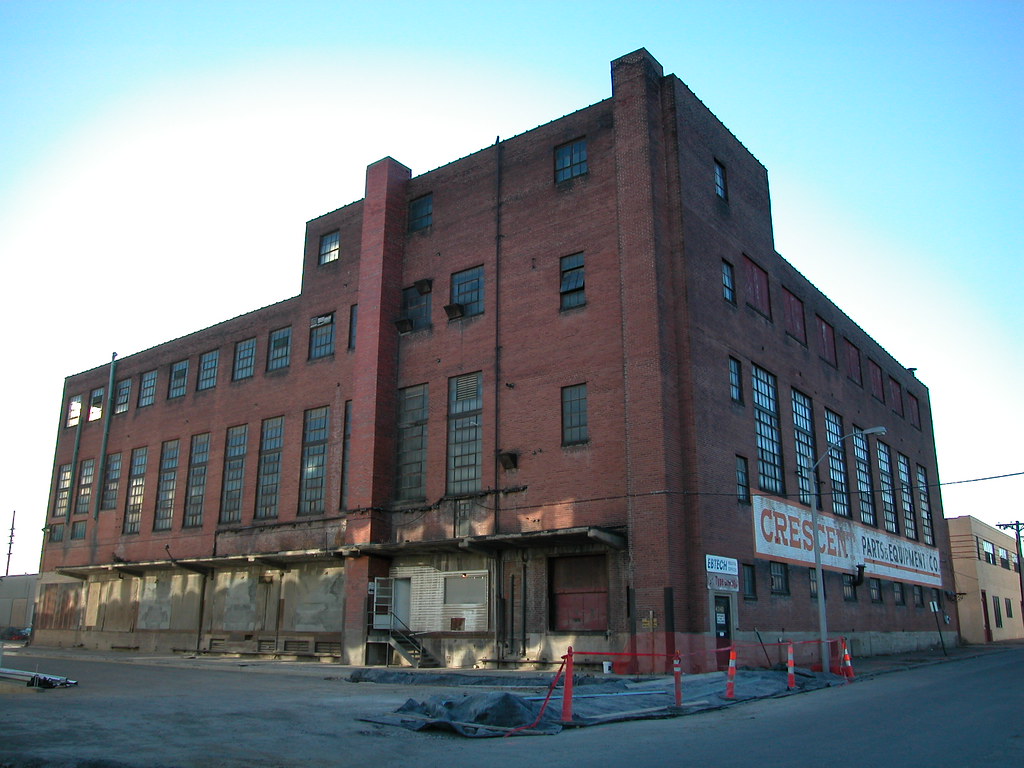 Washington University recently purchased this building, located at 4340 Duncan Avenue in the central corridor. The university's master plan for the Medical Center calls for demolition as part of the CORTEX redevelopment project. Although unadorned, and perhaps a bit sepulchral, the brick industrial building possesses several unique architectural features. Built in 1936 for a printing company, the building is the work of the noted firm Mauran, Russell and Crowell. The firm employed its characteristic genius here. While the concrete-framed fireproof building appears as a four story building, the second and third floors are actually a second floor and mezzanine. This arrangement allowed for production using machinery with overhead components on the second floor and distribution on the first floor, with loading bays lining the east wall (see the photo above). The floor arrangement allowed for the building to have a smaller footprint, saving room and creating a more urban form. The mezzanine arrangement is reflected in tall exterior windows that call to mind the same firm's earlier Federal Reserve Bank Building (1924) at Broadway and Locust downtown.
Washington University recently purchased this building, located at 4340 Duncan Avenue in the central corridor. The university's master plan for the Medical Center calls for demolition as part of the CORTEX redevelopment project. Although unadorned, and perhaps a bit sepulchral, the brick industrial building possesses several unique architectural features. Built in 1936 for a printing company, the building is the work of the noted firm Mauran, Russell and Crowell. The firm employed its characteristic genius here. While the concrete-framed fireproof building appears as a four story building, the second and third floors are actually a second floor and mezzanine. This arrangement allowed for production using machinery with overhead components on the second floor and distribution on the first floor, with loading bays lining the east wall (see the photo above). The floor arrangement allowed for the building to have a smaller footprint, saving room and creating a more urban form. The mezzanine arrangement is reflected in tall exterior windows that call to mind the same firm's earlier Federal Reserve Bank Building (1924) at Broadway and Locust downtown.In 1946, the St. Louis Post-Dispatch acquired the building and put it to use printing its popular Sunday lifestyle magazines. The Post expanded the building in 1959. In recent years, the building housed Crescent Electrical Supply. The former owner recently began clearing the building in preparation of its impending demolition. The loss is a shame. The lack of lavish ornament no doubt seals the fate, but that same quality gives the building an appearance consistent with its original use. While not a masterpiece, the building is a handsome modern industrial composition that is an important part of the character of Duncan Avenue. Besides, the building is almost built with adaptation in mind. All we need is a little imagination -- the sort of big thinking that led our leaders to envision CORTEX in the first place.





4 comments:
I agree that even though this building isn't the most outstanding, it is a good solid urban building and there isn't a reason why it shouldn't be re-used. If this building doesn't fit their needs, there are plenty of vacant spots nearby where they can build new.
More of the same reason this city takes three steps backward after one step forward. I suppose there is no possibility that CORTEXT would consider adaptive reuse schemes? Why do we have to continue to tear away what already have? Some classless concrete tilt-up will likely replace this fantastic specimen of industrial architecture that has shaped this area. Why don't we just get fleet of bulldozers and mow over the entirety of the early automobile industrial history in midtown to complete the erasure of this city's past?
From the Cortex website, regarding the new development:
The building has received silver pre-certification in the Leadership in Energy and Environmental Design Green Building Rating System for core and Shell Development (LEED-CS).
Future development throughout the Cortex district will be held to the same high standards, both to serve the life sciences industry and to protect the integrity of surrounding neighborhoods.
How is demolishing a historical and viable building protecting the integrity of the neighborhood? How can failing to reuse and recycle a viable building be considered "green"?
It can't. We've just completed a LEED project in University City, and are working toward several more. Of the number we're working on, a few are of historic buildings. When considering a LEED certification for existing buildings there is a balance that needs to be understood from the beginning of the planning process. From a materials and resources perspective, the inherentness of the green quality in existing buildings is obvious. From an energy conservation perspective, it becomes very costly to retrofit a historic building that, as a previous industrial use, is poorly insulated. A lot of weight is placed on energy aspects of LEED certification, and this often supercedes the preservation of historic artifact, unfortunately. I just wish entities and developers would be the very best stewards of our history and urban fabric that could possibly be, but it's just too much for a profit-making venture to be burdened with. Often the path to publicized and self-congratulatory sustainability runs right over the simplest logic of all, which is to work with what is already there.
Post a Comment